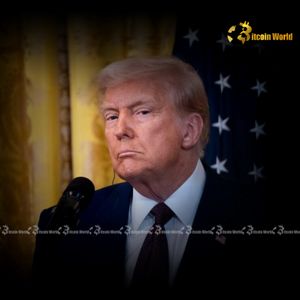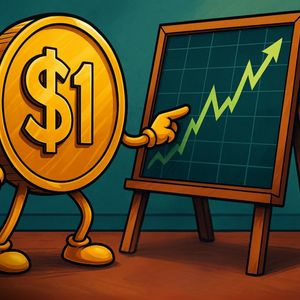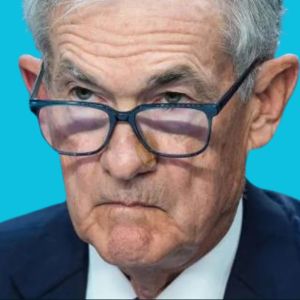Trump’s Shocking $1 Trillion Savings Claim: What It Means for Interest Rates and the Crypto Market
6 min read
BitcoinWorld Trump’s Shocking $1 Trillion Savings Claim: What It Means for Interest Rates and the Crypto Market Former U.S. President Donald Trump recently made a significant claim regarding the nation’s finances, suggesting that a specific action by the Federal Reserve could lead to massive annual savings. For those tracking the pulse of the Crypto Market , understanding such macroeconomic discussions is crucial, as they often provide insights into the potential flow of capital and investor sentiment. Let’s break down Trump’s statement and explore its possible implications for the broader US Economy and digital assets. What Did Trump Say About Interest Rates ? In a post on Truth Social, Donald Trump asserted that if Federal Reserve Chair Jerome Powell were to lower benchmark Interest Rates to a range of 1% to 2%, the United States government could realize annual savings of up to $1 trillion. This bold claim ties the direct cost of government borrowing to the Fed’s monetary policy decisions. Trump also used the statement as an opportunity to criticize the current administration, attributing what he sees as high costs to the policies enacted under President Biden. His remarks position the lowering of Interest Rates not just as an economic adjustment but as a significant fiscal maneuver with substantial savings potential. How Do the Federal Reserve’s Actions Influence the US Economy ? The Federal Reserve , often referred to as the ‘Fed’, is the central banking system of the United States. Its primary tool for influencing the US Economy is setting the target range for the federal funds rate – the interest rate banks charge each other for overnight borrowing. This rate serves as a benchmark that influences other interest rates throughout the economy, including: Rates on mortgages and car loans Interest earned on savings accounts and bonds Borrowing costs for businesses The cost of government debt When the Fed lowers Interest Rates , it typically aims to stimulate economic activity by making borrowing cheaper, encouraging spending and investment. Conversely, raising rates is intended to cool down an overheating economy and combat inflation by making borrowing more expensive. Trump’s argument centers on the government’s own borrowing costs. The U.S. government issues Treasury bonds and other debt instruments to finance its operations and existing debt. The interest paid on this debt is a significant government expense. Lowering market Interest Rates generally leads to lower yields on newly issued government debt, potentially reducing the government’s annual interest payments, which is the basis for Trump’s $1 trillion savings claim. Could Lower Interest Rates Really Save $1 Trillion? The potential savings figure cited by Trump is substantial and depends on several factors, including the total amount of outstanding government debt, the average maturity of that debt, and the speed at which lower rates would translate into lower borrowing costs for new or refinanced debt. Here’s a simplified look at the concept: The U.S. national debt is currently in the tens of trillions of dollars. A portion of this debt matures regularly and must be refinanced by issuing new debt. If the prevailing Interest Rates are lower when new debt is issued, the interest payments on that new debt will be lower. Over time, as more high-interest debt matures and is replaced by lower-interest debt, the total annual interest expense could decrease significantly. However, reaching a $1 trillion annual saving depends on a rapid and sustained drop in borrowing costs across a vast amount of debt. Economists have varying estimates on the potential savings from lower rates, and $1 trillion is generally considered to be at the higher end of projections, potentially requiring a more significant and prolonged rate reduction than the 1-2% target range mentioned by Trump, or assuming a very rapid turnover of existing debt. Furthermore, the Federal Reserve’s decisions are based on its dual mandate: achieving maximum employment and stable prices (controlling inflation). While the impact on government borrowing costs is a consideration, it is not the primary driver of monetary policy. The Fed must weigh the potential benefits of lower rates (like reduced government interest expense and economic stimulation) against the risks, particularly the risk of fueling inflation, which could ultimately harm the US Economy . What is the Potential Crypto Market Impact? Discussions around Interest Rates and the US Economy are closely watched by participants in the Crypto Market . Here’s why: Risk-On Sentiment: Lower interest rates typically make traditional, safer investments like bonds less attractive due to lower yields. This can encourage investors to seek higher returns in riskier assets, including stocks and cryptocurrencies. This is often referred to as a ‘risk-on’ environment. Liquidity: When the Fed lowers rates or engages in quantitative easing (another monetary tool), it generally increases the overall liquidity in the financial system. More money flowing through the economy can find its way into various asset classes, including crypto. Inflation Hedges: While the Fed’s goal with higher rates has been to combat inflation, some investors view assets like Bitcoin as a potential hedge against currency devaluation, especially if expansive monetary policies (like very low rates) are pursued over long periods. Comparison to Traditional Finance: As interest rates rise, the cost of capital increases for businesses, potentially slowing growth. For speculative assets like many cryptocurrencies, a lower-rate environment can make their potential future value more appealing compared to the lower returns offered elsewhere. If the Federal Reserve were to significantly lower Interest Rates towards the 1-2% range suggested by Trump , many analysts would anticipate this being a bullish signal for the Crypto Market , assuming other economic factors remain stable. Cheaper borrowing could also potentially free up capital for institutional or individual investors to allocate to digital assets. Navigating Economic Statements: Actionable Insights For those involved in the Crypto Market , keeping an eye on macroeconomic indicators and political commentary is important, but it’s crucial to approach them with a critical perspective. Distinguish Policy from Proposal: Trump’s statement is a proposal and a critique, not current Fed policy. The Fed operates independently and makes decisions based on complex economic data, not political directives. Understand the ‘Why’: Consider the context and potential motivations behind political statements on the economy. Focus on Fed Communication: Pay closer attention to official statements and minutes from the Federal Reserve ‘s Federal Open Market Committee (FOMC) meetings for actual policy direction. Long-Term vs. Short-Term: While a significant shift in Interest Rates could have long-term implications for the Crypto Market , short-term market movements are influenced by a vast array of factors, including regulation, technological developments, and market sentiment specific to crypto. Do Your Own Research: Economic forecasts and the impact of policy are complex and subject to change. Rely on diverse sources of information and conduct thorough research before making investment decisions based on macroeconomic predictions. While the prospect of $1 trillion in savings is a headline-grabbing figure, the path to achieving it through significantly lower Interest Rates involves intricate economic trade-offs that the Federal Reserve must navigate carefully to ensure the long-term health of the US Economy . The reaction of the Crypto Market to any such policy shift would be just one piece of the larger economic puzzle. Summary Donald Trump has put forward the idea that lowering Federal Reserve Interest Rates to 1-2% could save the US Economy $1 trillion annually, while also criticizing current policy. While lower rates can indeed reduce government borrowing costs and historically tend to favor risk-on assets like those in the Crypto Market , the Fed’s decisions are driven by broader economic mandates like employment and inflation control. The potential savings figure is significant but depends on many variables. For crypto enthusiasts, this serves as a reminder that macroeconomic policy is a key factor to monitor, but official Fed actions and a comprehensive understanding of economic dynamics are more reliable indicators than political statements alone. To learn more about the latest Crypto Market trends and their connection to global economic factors, explore our articles on key developments shaping Bitcoin and the broader digital asset space. This post Trump’s Shocking $1 Trillion Savings Claim: What It Means for Interest Rates and the Crypto Market first appeared on BitcoinWorld and is written by Editorial Team

Source: Bitcoin World



